Catch-Based Stock Assessment of Silver Croaker (Pennahia argentata) Based on Different Fishing Indicators in the East China Sea
Abstract
Data limitations in multispecies fisheries make traditional stock assessments challenging for many developing coastal countries. Despite China’s large marine ecosystems, most fish stocks remain unassessed. This study evaluates the stock status of silver croaker (Pennahia argentata) in the East China Sea (ECS) from 2003 to 2022 using catch-based methods and data from the China Fisheries Statistical Yearbook (CFSY). Three models indicate that the 2022 catch is below the estimated maximum sustainable yield (MSY), suggesting a healthy stock status. The study also tests four catch per unit effort (CPUE) indicators, finding that combining CPUE2 and CPUE4 in the just another Bayesian biomass assessment (JABBA) model yields the best fit. Sensitivity analysis highlights the importance of initial biomass settings in JABBA. Given the limitations of catch-based models like catch-MSY plus plus (CMSY++) and the absence of survey data, a more conservative management approach is recommended. Additionally, the catch-to-trawl vessel horsepower ratio is suggested as a reliable CPUE indicator. These findings support more accurate assessments and sustainable management of silver croaker in the ECS.
1. Introduction
Fisheries resource assessment is the process of evaluating fish stocks and fishing dynamics by integrating information from fish life history, fisheries monitoring, resource surveys, and commercial catch data. This assessment utilizes mathematical models to predict trends in resource quantities under different management strategies and to conduct risk evaluations [1, 2]. Traditional assessment methods are data-intensive and require high-quality inputs [3]. Currently, the Food and Agriculture Organization (FAO) [4] global marine fisheries database includes catch data for over 2600 species. However, the majority of catch data cannot be disaggregated by individual species and fewer than 5% of species undergo complete stock assessments [5]. Consequently, only a limited number of major commercial fish species worldwide have been evaluated through detailed, complex, and systematic stock assessments. These assessments generally require time-series data on catch quantities, age structure, length–weight distribution, gonad maturity, relative or absolute abundance, and accurate life history parameters [6]. For certain low-value or bycatch fisheries, reference indicators like biomass and fishing mortality cannot be obtained through comprehensive quantitative assessments due to data gaps. Such fisheries are referred to as data-limited fisheries [7, 8].
The East China Sea (ECS), located on the western edge of the Pacific Ocean of China’s eastern coast, is the most productive fishery area in the country [9]. According to the China Fisheries Statistical Yearbook (CFSY), since 1979, the ECS region has consistently contributed the largest share of China’s total marine catch. In 1981, the catch from this region accounted for 53.76% of the national marine catch, and in 1998, it reached an all-time high of 5,538,147 tons [10]. However, as fishing pressure has gradually increased, the region’s resources have continued to decline, leading to shifts in traditional fishing targets and a reduction in the trophic level of target species [9]. To ensure the sustainable development of fisheries in the ECS, it is essential to continuously monitor and assess key fishery resources. Through scientific evaluation and management measures, it is possible to effectively protect the ecosystem, maintain stable fishery production, and ensure the long-term sustainability of these resources.
Silver croaker (Pennahia argentata) belongs to the order Perciformes and the family Sciaenidae. It is a warm-temperate and near-bottom fish species widely distributed in the Indian Ocean and western Pacific Ocean and is one of the economically important fish species with a high yield [11]. Silver croaker is found along China’s coastal waters, with a higher presence in the ECS [12, 13]. According to the CFSY, the catch of silver croaker in the ECS showed an initial increase followed by a decline from 2003 to 2022. The catch was approximately 60,000 tons in 2003, peaked at around 71,600 tons in 2010, and has shown a declining trend in recent years, remaining around 60,000 tons [10, 14]. Although earlier studies on the silver croaker in the ECS primarily focused on age, growth, and feeding habits [15, 16], recent research has increasingly addressed stock assessment. For example, Zhao et al. [17] evaluated the exploitation status of the species in the ECS, while Ju et al. [18] assessed the stock status of multiple commercial fish species, including silver croaker, in the coastal and offshore waters of Taiwan, which are part of the ECS, using the catch-maximum sustainable yield (CMSY) and Bayesian state-space Model (BSM) methods.
Due to the limited research on silver croaker in the ECS, scientific management faces challenges. This study addresses these gaps by collecting marine catch and fishing effort data for silver croaker in the ECS region from the CFSY. Based on these data, catch per unit effort (CPUE) was calculated as an index of relative abundance. Subsequently, the stock status of silver croaker was assessed using three catch-based models: CMSY plus plus (CMSY++), BSM, and just another Bayesian biomass assessment (JABBA). These models are commonly employed in the assessment of data-limited fisheries resources. For instance, Kindong et al. [19] utilized the CMSY++ model to assess the resources of the blue shark (Prionace glauca) in the South Atlantic. Liang, Xian, and Pauly [20] employed the CMSY and BSM models to evaluate the status of 15 marine fish and invertebrate populations captured by fishing vessels from China, South Korea, and Japan. Moreover, Dai et al. [21] evaluated catch-only methods, including CMSY++, to inform fisheries management in the ECS, further demonstrating the applicability of these models in data-limited situations and providing important references for stock assessments in the region. Additionally, Winker et al. [22] conducted assessments of the shortfin mako shark (Isurus oxyrinchus) in the north and south Atlantic using the JABBA model. Still in the Atlantic Ocean, Kindong et al. [23, 24] applied JABBA to assess the stocks of European anchovy and sardine, small-sized fish species as silver croaker.
In the same light, evaluating the degree of biomass depletion as evidence of fishing pressure and providing alternative harvesting policies is of great importance. The main goal of this study is to estimate the stock status and maximum sustainable yield (MSY) of silver croaker by using the aforementioned three catch-based assessment methods. Based on the different estimates from the models, we make recommendations on exploitation options at the MSY level and propose which CPUE indicator is preferable based on available silver croaker data. Hence, this study aims to provide a scientific basis for the stock management of silver croaker, contributing to the formulation of effective conservation and sustainable utilization strategies.
2. Materials and Methods
2.1. Data Sources
2.2. Modeling Approaches and Data Analyses
2.2.1. CMSY++ and BSM
The CMSY method was improved and proposed by Froese et al. [27] in 2017. Unlike the CMSY method, CMSY employs empirical rules to select optimal values for r and k, rather than simply taking the geometric mean. In this method, the optimal r is defined as the 75th percentile of the feasible distribution of r values, while the corresponding k is selected based on the central tendency that aligns with the optima.
CMSY++ is an advanced version of CMSY. It replaces the Monte Carlo methods used in the original CMSY with a “catch-only” Bayesian approach. Artificial neural network (ANN) is introduced to estimate the initial and final stock states based on catch time series, resulting in more reliable priors. Additionally, CMSY++ uses a multivariate log-normal (MVLN) distribution to better address the negative correlation between r and k, thereby, providing more realistic biomass estimates.
2.2.2. JABBA
2.2.3. Parameter Settings and Scenario Establishment
This study employs three models CMSY++, BSM, and JABBA to conduct stock assessment analyses for the silver croaker in the ECS. The CMSY++ model is a data-limited model based on catch data, while the BSM and JABBA models require additional biomass or CPUE data along with the catch data. To investigate the differences in evaluation results among the three models, this study established a total of 14 basic scenarios.
Additionally, the setting of prior information significantly influences the results of the models. Due to the lack of relevant assessment reports for silver croaker prior to 2003, this study established nine control group scenarios based on the research by Froese et al. [27], categorizing the initial biomass depletion levels into three classes (low, medium, and high) and utilizing different relative initial biomasses (BStart/k) for sensitivity analysis. The remaining settings are based on model defaults, detailed as in Table 1.
| Scenario | CPUE | r | Bstart /k.low | Bstart /k.hi |
|---|---|---|---|---|
| CMSY1 | NA | U (0.37,0.85) | 0.1 | 1 |
| CMSY2 (high) | NA | U (0.37,0.85) | 0.01 | 0.4 |
| CMSY3 (medium) | NA | U (0.37,0.85) | 0.2 | 0.6 |
| CMSY4 (low) | NA | U (0.37,0.85) | 0.4 | 0.8 |
| BSM1 | CPUE1 | U (0.37,0.85) | 0.1 | 1 |
| BSM2 | CPUE2 | U (0.37,0.85) | 0.1 | 1 |
| BSM3 | CPUE3 | U (0.37,0.85) | 0.1 | 1 |
| BSM4 | CPUE4 | U (0.37,0.85) | 0.1 | 1 |
| BSM5 (high) | CPUE1 | U (0.37,0.85) | 0.01 | 0.4 |
| BSM6 (medium) | CPUE1 | U (0.37,0.85) | 0.2 | 0.6 |
| BSM7 (low) | CPUE1 | U (0.37,0.85) | 0.4 | 0.8 |
- Note: CPUE1 is the ratio of catch to the number of ocean-going motorized fishing vessels, CPUE2 is the ratio of catch to the total power of ocean-going motorized fishing vessels, CPUE3 is the ratio of catch to the number of trawl fishing vessels, and CPUE4 is the ratio of catch to the total power of trawl fishing vessels.
2.2.4. Model Comparison and Retrospective Analysis
3. Results
3.1. Model Fitting
In this study, four types of CPUE indicators were employed. The BSM model was configured with four basic scenarios (BSM1–BSM4), while the JABBA model was designed with a total of nine basic scenarios (JABBA1–JABBA9) using various combinations. Detailed parameter settings are provided in Tables 1 and 2.
| Scenario | CPUE | r | k | Start B/k |
|---|---|---|---|---|
| JABBA1 | CPUE1-4 | U (0.37,0.85) | U (50000,700000) | log-normal (0.3,0.5) |
| JABBA2 | CPUE2,4 | U (0.37,0.85) | U (50000,700000) | log-normal (0.3,0.5) |
| JABBA3 | CPUE1,3 | U (0.37,0.85) | U (50000,700000) | log-normal (0.3,0.5) |
| JABBA4 | CPUE1,2 | U (0.37,0.85) | U (50000,700000) | log-normal (0.3,0.5) |
| JABBA5 | CPUE3,4 | U (0.37,0.85) | U (50000,700000) | log-normal (0.3,0.5) |
| JABBA6 | CPUE1 | U (0.37,0.85) | U (50000,700000) | log-normal (0.3,0.5) |
| JABBA7 | CPUE2 | U (0.37,0.85) | U (50000,700000) | log-normal (0.3,0.5) |
| JABBA8 | CPUE3 | U (0.37,0.85) | U (50000,700000) | log-normal (0.3,0.5) |
| JABBA9 | CPUE4 | U (0.37,0.85) | U (50000,700000) | log-normal (0.3,0.5) |
| JABBA10 (high) | CPUE1-4 | U (0.37,0.85) | U (50000,700000) | log-normal (0.15,0.3) |
| JABBA11 (medium) | CPUE1-4 | U (0.37,0.85) | U (50000,700000) | log-normal (0.3,0.25) |
| JABBA12 (low) | CPUE1-4 | U (0.37,0.85) | U (50000,700000) | log-normal (0.55,0.15) |
The results indicate that all four scenarios of the BSM model demonstrated good fitting performance for the catch data. Process error analysis showed that the biomass changes in all four scenarios aligned well with the expectations of the Schaefer model. Additionally, the logarithmic residuals of the fitted CPUE values conformed to a random distribution. Among all CPUE indicators, the CPUE1 scenario (the ratio of catch to the number of ocean motorized fishing vessels) exhibited the best fit between predicted and observed values, while the fitting results for the other scenarios were also satisfactory (Figure 1).
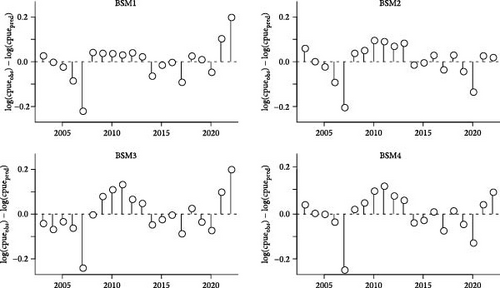
For the nine scenarios of the JABBA model, the fitting effectiveness was assessed by comparing the deviance information criterion (DIC) values and RMSE. Smaller DIC and RMSE values indicate better model fitting performance [39]. The results revealed that the JABBA model performed well when using combinations of CPUE2 and CPUE4, although the overall differences among the nine scenarios were minimal (Table 3). The posterior distributions of all parameters were symmetrically distributed and fell within reasonable ranges, indicating that the model converged and produced reliable results (Figures 2–4).
| Performance indices | JABBA1 | JABBA2 | JABBA3 | JABBA4 | JABBA5 | JABBA6 | JABBA7 | JABBA8 | JABBA9 |
|---|---|---|---|---|---|---|---|---|---|
| RMSE (%) | 10.5 | 5.1 | 5.7 | 11.9 | 10.2 | 6.2 | 6.8 | 7.1 | 7.5 |
| DIC | −559.2 | −580.6 | −180.7 | −393.1 | −315.6 | −197.8 | −379.8 | −135.1 | −352.6 |
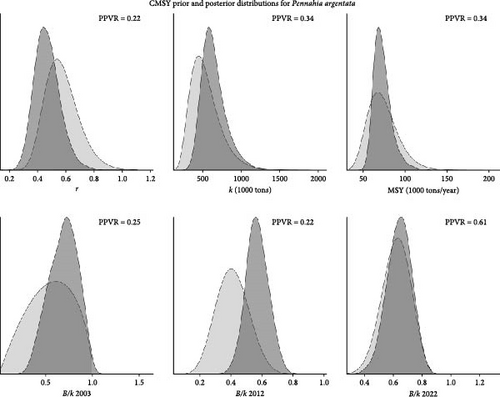
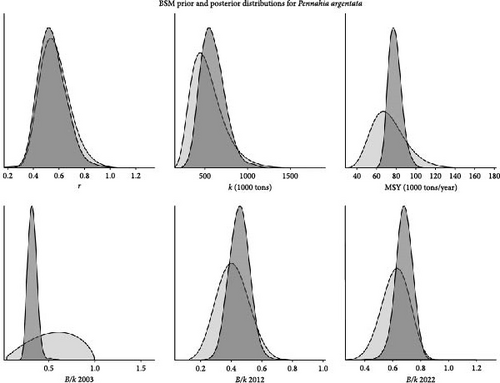
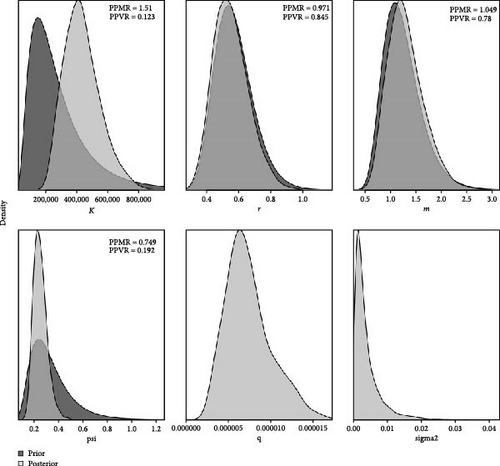
3.2. Stock Status
The results indicate that under the 23 scenarios set in this study (14 basic scenarios + 9 control scenarios), the MSY of the ECS silver croaker ranges from approximately 68,000 to 84,000 tons, with r ranging from 0.50 to 0.61 and k between 331,000 and 623,000 tons. Among all the evaluation results, only the JABBA10 scenario, using the JABBA model with four different CPUE data fits and an initial biomass at a high level of depletion (BStart/k range of 0.01–0.4), classifies the stock status of the ECS silver croaker in 2022 as overfished. In contrast, all other scenarios show that the stock remains healthy in 2022 (Table 4).
| Scenario | MSY (×105 tons) |
r | k (×105 tons) |
BMSY (×105 tons) |
FMSY | B2022/BMSY | F2022/FMSY |
|---|---|---|---|---|---|---|---|
| CMSY1 |
|
|
|
|
|
|
|
| CMSY2 |
|
|
|
|
|
|
|
| CMSY3 |
|
|
|
|
|
|
|
| CMSY4 |
|
|
|
|
|
|
|
| BSM1 |
|
|
|
|
|
|
|
| BSM2 |
|
|
|
|
|
|
|
| BSM3 |
|
|
|
|
|
|
|
| BSM4 |
|
|
|
|
|
|
|
| BSM5 |
|
|
|
|
|
|
|
| BSM6 |
|
|
|
|
|
|
|
| BSM7 |
|
|
|
|
|
|
|
| JABBA1 |
|
|
|
|
|
|
|
| JABBA2 |
|
|
|
|
|
|
|
| JABBA3 |
|
|
|
|
|
|
|
| JABBA4 |
|
|
|
|
|
|
|
| JABBA5 |
|
|
|
|
|
|
|
| JABBA6 |
|
|
|
|
|
|
|
| JABBA7 |
|
|
|
|
|
|
|
| JABBA8 |
|
|
|
|
|
|
|
| JABBA9 |
|
|
|
|
|
|
|
| JABBA10 |
|
|
|
|
|
|
|
| JABBA11 |
|
|
|
|
|
|
|
| JABBA12 |
|
|
|
|
|
|
|
In this study, when the range for BStart/k was set between 0.1 and 1, the three different models generated a total of 14 basic scenarios using various combinations of CPUE. The results showed that the biomass of the silver croaker exhibited a fluctuating upward trend over the years, with B/BMSY trending upward and F/FMSY trending downward. However, during the period from 2007 to 2013, F/FMSY experienced a slight increase, which affected the growth rate of biomass and B/BMSY, causing some model results to show a slower increase or even a decrease (Figure 5).
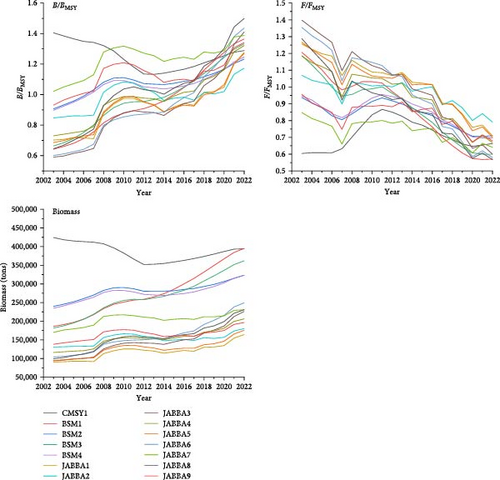
There were slight differences in the results of the basic scenarios among the three models. In the CMSY++ and BSM models, there was a greater than 90% probability that the silver croaker population would be in a healthy state by 2022 (Figure 6). In the JABBA model, except for the JABBA2 scenario (which used the ratio of catch to the number of marine fishing vessels as CPUE), which had only a 69.2% probability of being in a healthy state, all other scenarios had probabilities of being in a healthy state above 80% (Figure 7). Among the different results from the three models, CMSY++ provided a more optimistic analysis. There were slight differences in the results of the basic scenarios among the three models. In the CMSY++ and BSM models, there was a greater than 90% probability that the silver croaker population would be in a healthy state by 2022 (Figure 6). In the JABBA model, except for the JABBA2 scenario (which used the ratio of catch to the number of marine fishing vessels as CPUE), which had only a 69.2% probability of being in a healthy state, all other scenarios had probabilities of being in a healthy state above 80% (Figure 7). Among the different results from the three models, CMSY++ provided a more optimistic analysis of the population status, indicating that the silver croaker population was consistently in a healthy state. In contrast, the BSM and JABBA models indicated that the silver croaker population was in a state of overfishing in 2003, but its status has been recovering to a healthy level over time.
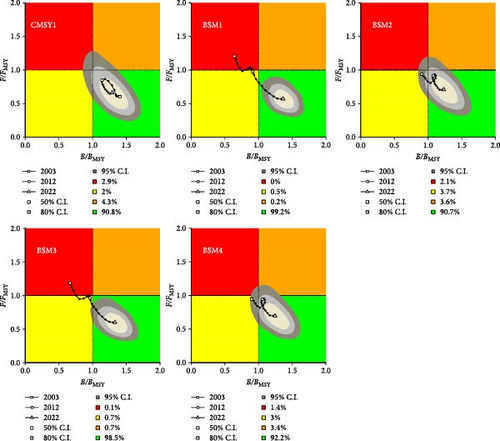
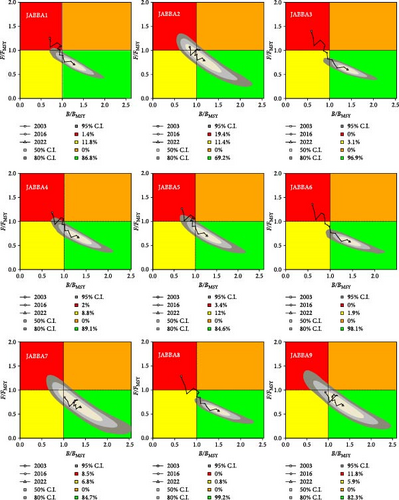
3.3. Retrospective Analysis
Retrospective analysis reveals that the results of the basic scenarios exhibit a certain degree of retrospective bias across all models. In the three models, Mohn’s ρ falls within the range of (−0.15, 0.2), with the smallest absolute value of Mohn’s ρ occurring in the JABBA9 scenario (Table 5). In the CMSY++ and BSM models, the B/BMSY parameter values are overestimated, while F/FMSY may be underestimated (Figure 8). The retrospective analysis of the JABBA model demonstrates significant variability in the results across different scenarios (Figure 9).
| Model scenarios | Mohn’s ρ values of B/BMSY | Mohn’s ρ values of F/FMSY |
|---|---|---|
| CMSY1 | 0.027 | −0.048 |
| BSM1 | 0.059 | −0.038 |
| BSM2 | 0.044 | −0.059 |
| BSM3 | 0.079 | −0.082 |
| BSM4 | 0.063 | −0.062 |
| JABBA1 | −0.056 | 0.055 |
| JABBA2 | 0.116 | −0.103 |
| JABBA3 | 0.154 | −0.110 |
| JABBA4 | 0.074 | −0.061 |
| JABBA5 | 0.186 | −0.144 |
| JABBA6 | 0.116 | −0.081 |
| JABBA7 | −0.032 | 0.048 |
| JABBA8 | 0.114 | −0.108 |
| JABBA9 | 0.003 | >0.001 |
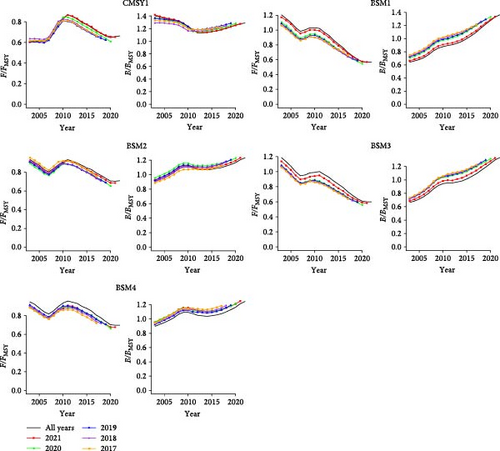
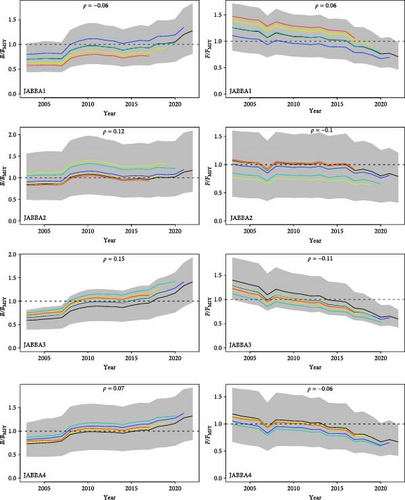


3.4. Sensitivity Analysis
This study explores the impact of prior settings for BStart/k on the results by establishing three control groups. In these groups, based on the research by Froese et al. [27], the initial biomass depletion levels are categorized into three classes (high, medium, and low), while the other prior parameter settings remain consistent. The groups are as follows: CMSY (2, 3, and 4), BSM (5, 6, and 7), and JABBA (10, 11, and 12); detailed prior parameter settings are provided in Table 4.
3.4.1. CMSY++
The dynamic trends of population parameters in the CMSY++ model indicate that in the CMSY2 scenario (high depletion), both biomass and B/BMSY exhibit rapid growth. Even though F/FMSY experienced a brief increase between 2007 and 2009, biomass and B/BMSY did not show a significant decline, unlike in the CMSY3 (medium depletion) and CMSY4 (low depletion) scenarios. In the CMSY3 and CMSY4 scenarios, biomass and B/BMSY display fluctuating growth trends, with biomass and B/BMSY experiencing more pronounced changes as F/FMSY increases. Initially, the model fit values differ significantly, but they gradually converge to become more similar towards the end (Figure 10). The remaining results from the CMSY++ model indicate that higher prior settings for BStart/k lead to higher values of MSY, k, and BMSY (Table 4). The Kobe plot shows that under all three scenarios, there is over a 90% probability that the silver croaker in the ECS will be in a healthy state by 2022 (Figure 11). The prior and posterior probability distribution plots indicate that different BStart/k settings have a significant impact on BStart/k in the posterior distribution, while the influence on the posterior distributions of other parameters remains relatively small (Appendix A).
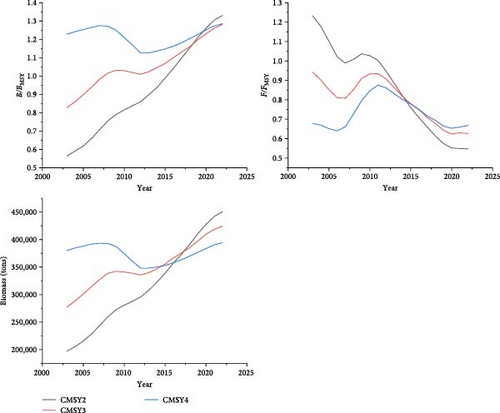

3.4.2. BSM
The dynamic trends of population parameters in the BSM model show that the changes in biomass, B/BMSY, and F/FMSY are similar across all three scenarios. Notably, between 2007 and 2009, there was a brief increase in F/FMSY, followed by a slowdown in the growth of both B/BMSY and F/FMSY. Additionally, the initial differences in model fitting values were significant, but these gradually converged and became more similar over time (Figure 12). Other results from the BSM model indicate that higher prior settings for BStart/k lead to higher values for MSY, k, and BMSY (Table 4). The Kobe plot shows that under all three scenarios, there is over a 98% probability that the stock status of silver croaker in 2022 will remain healthy (Figure 13). The prior and posterior probability distribution plots indicate that in the BSM5 (high depletion) and BSM6 (medium depletion) scenarios, the posterior distributions of parameters show little variation. However, in the BSM7 (low depletion) scenario, the posterior distribution for B/k is notably higher overall (Appendix B).
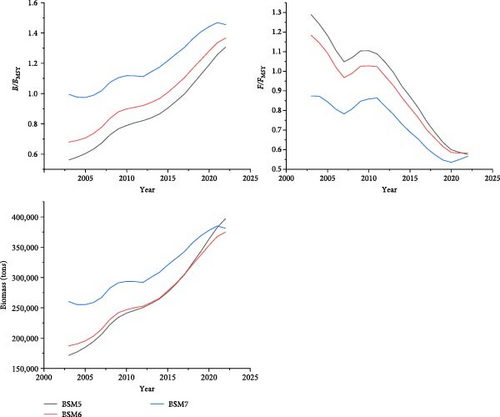
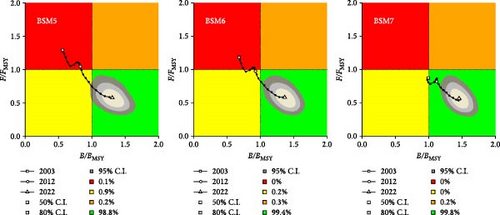
3.4.3. JABBA
The dynamic trends of population parameters in the JABBA model indicate that the changes in biomass, B/BMSY, and F/FMSY are similar across the three scenarios. However, the fitting results of the JABBA model did not converge gradually at the end and the results for different scenarios varied significantly in the final year (Figure 14). Additionally, results from the JABBA model show that a higher prior setting for BStart/k leads to a higher value of r (Table 4). The Kobe plot shows that under the three scenarios for 2022, the stock status of the silver croaker has only a 38.8% probability of being healthy when the initial level of population depletion is assumed to be high; an 83.9% probability of being healthy when the initial level of depletion is moderate; and a 100% probability of being healthy when the initial depletion level is low (Figure 15). The prior and posterior probability distribution plots show that different prior settings for BStart/k have a significant impact on the posterior distributions of k, r, and psi (BStart/k; Appendix C).
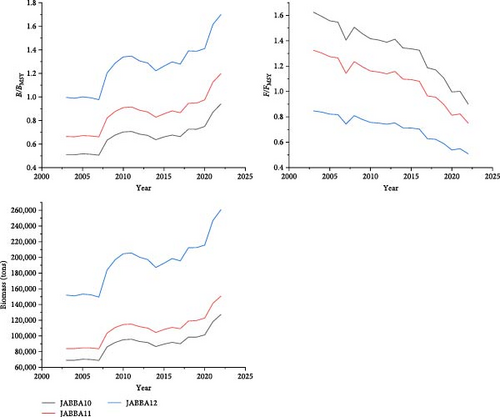
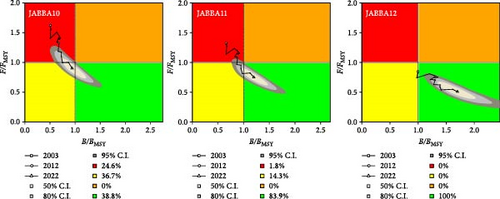
3.4.4. Summary
The analysis of the dynamic changes in population parameters of the silver croaker in the ECS revealed differing results and trends across all three models (CMSY++, BSM, and JABBA). In the CMSY++ and BSM models, higher prior settings for BStart/k resulted in increases in MSY, k, and BMSY values, while the final model fitting values showed significant convergence. The Kobe plots for the CMSY++ and BSM models indicated that there is over a 90% probability of the silver croaker being in a healthy state by 2022. The JABBA model exhibited similar trends in biomass, B/BMSY, and F/FMSY changes; however, it is fitting results did not converge, showing substantial differences between scenarios in the final year’s results. Nevertheless, the higher prior settings of BStart/k also led to increased posterior results for r and the Kobe plots demonstrated that different assumed initial levels of population depletion significantly influenced the outcomes. Retrospective analyses of the three control groups indicated that when the prior setting for BStart/k was between 0.4 and 0.8, the Mohn’s ρ values for the CMSY++ and BSM models were closest to 0. In the JABBA model, the Mohn’s ρ value closest to 0 was observed in the JABBA10 scenario (high depletion level; Table 6).
| Model scenarios | Mohn’s ρ values of B/BMSY | Mohn’s ρ values of F/FMSY |
|---|---|---|
| CMSY2 | 0.089 | −0.122 |
| CMSY3 | 0.062 | −0.085 |
| CMSY4 | 0.015 | −0.017 |
| BSM5 | 0.099 | −0.080 |
| BSM6 | 0.059 | −0.049 |
| BSM7 | −0.002 | 0.014 |
| JABBA10 | 0.057 | −0.047 |
| JABBA11 | 0.121 | −0.096 |
| JABBA12 | 0.098 | −0.107 |
The results suggest that the JABBA model is more sensitive to prior settings for BStart/k compared to the CMSY++ and BSM models.
4. Discussion
Given that fishing pressure on most small pelagic and demersal species in coastal waters continues to rise, it is essential to assess these stocks using a variety of assessment methods based on data available. This approach captures the full range of uncertainties and provides results that can directly inform sustainable harvest strategies, thereby, facilitating the development of effective management measures.
The present study assessed silver croakers’ stock from the ECS using three assessment approaches and ran various sensitivity analyses based on data and input parameters used. These models are not only valuable for the ECS but have also been widely applied in other ecosystems to guide catch limit setting and management decisions. For instance, Jiang et al. [40] conducted a resource assessment of the Indian Ocean swordfish (Xiphias gladius) stock using the JABBA and JABBA-SELECT models, demonstrating that the stock is in a healthy condition. The models further predicted that overfishing would not occur before 2028 if the total allowable catch (TAC) remains below 36,000 tons; Nisar et al. [41] conducted a stock assessment of tuna resources in the eastern and western Indian Ocean using the CMSY and BSM models. The results indicated an urgent need to reduce fishing pressure to mitigate the decline in fishery resources. Kindong et al. [19] utilized the CMSY++ model to assess the resources of the blue shark in the South Atlantic.
4.1. Stock Status of Silver Croaker in the ECS
This study estimated the stock status of silver croaker in the southern Zhejiang coastal waters from 2003 to 2022 using the CMSY++, BSM, and JABBA models. The stock parameter estimates for the baseline scenario from all three models indicated that the MSY estimates for silver croaker in the ECS were higher than the 2022 catch and the stock was likely to be in a healthy state. The ECS, as the most productive marine area in China, experienced overfishing and a decline in trophic levels during the 1980s and 1990s due to increased fishing pressure [42]. During this period, silver croaker gradually became one of the key target species, resulting in limited early studies on the species in the ECS. Recent research on this species has emerged only in the past few years [15, 16]. This study summarizes the stock status of silver croaker in the ECS and surrounding waters to facilitate comparison (Table 7). Compared to recent studies in the ECS, such as those by Liang et al. [20] and Ren et al. [43], the results of this study differ significantly. This discrepancy can mainly be attributed to the catch and CPUE data used in this study, which were sourced from the CFSY and carry inherent uncertainty.
| Study area | Sampling time | Model | MSY (×105) | B/BMSY | F/FMSY | F0.1 | E | Reference |
|---|---|---|---|---|---|---|---|---|
| The East China Sea | 2019 | CMSY | 0.64 | 0.961 | 0.933 | — | — | [20] |
| The East China Sea | 2019 | BSM | 0.64 | 0.653 | 1.413 | — | — | [20] |
| Coastal waters of southern Zhejiang | 2016 | YPR | — | — | — | 0.78 | 0.7 | [43] |
| Northern South China Sea | 1964 | ELEFAN | — | — | — | — | 0.49 | [44] |
| Northern South China Sea | 1992 | ELEFAN | — | — | — | — | 0.58 | [44] |
| Northern South China Sea | 1997 | ELEFAN | — | — | — | — | 0.74 | [44] |
| The East China Sea | 2022 | CMSY++ | — | 1.28–1.33 | 0.55–0.67 | — | — | This study |
| The East China Sea | 2022 | BSM | — | 1.23–1.46 | 0.57–0.71 | — | — | This study |
| The East China Sea | 2022 | JABBA | — | 0.94–1.70 | 0.51–0.90 | — | — | This study |
- Note: F0.1 represents the fishing mortality rate when the yield per recruit (YPR) growth rate reaches 0.1 times its maximum value, corresponding to YPR0.1.
Furthermore, the use of catch effort data from the same source tends to produce more optimistic assessments, aligned with the findings of Han et al. [45]. In addition to the uncertainty in the data, other factors influencing the results of this study, as compared to those of Ren et al. [43] and Chen, Qiu, and Huang [44], include the migratory behavior of silver croaker. The coastal waters of Zhejiang serve as an important spawning ground for the species, with a high proportion of juveniles in the catch. Adult silver croaker, however, tend to migrate offshore as water temperatures decrease [46], which likely contributes to the variability in the fishery data used in this study. Therefore, this study recommends that when using data from the CFSY for stock assessments without scientific survey CPUE data, the results should be interpreted with caution as they are likely to be more optimistic. If these results are to be used for fisheries management, more conservative management strategies should be adopted.
4.2. Selection of Best Fit CPUE Indicator
To explore the feasibility of using the fishing effort data from the CFSY for stock assessments, this study employed four different CPUE indicators. The results from different models showed that, among the four schemes of the BSM model, the logarithmic residuals of the CPUE fit followed a random distribution. Among the nine schemes of the JABBA model, lower DIC and RMSE values were observed, with the best fit occurring when CPUE2 and CPUE4 combinations were used. In the retrospective analysis, the Mohn’s ρ for all schemes of the three models fell within the range of (−0.15, 0.2), indicating that the results from all schemes are acceptable [47]. Notably, the absolute value of Mohn’s ρ for JABBA Scheme 9 was closest to 0. This could be due to the ability of JABBA’s state-space modeling to reduce uncertainties from both observation errors and process errors, thereby, mitigating certain retrospective issues [33]. Additionally, it was found that when using the ratio of catch to the total horsepower of trawl vessels as the CPUE data, the results were the most stable with smaller retrospective errors. Therefore, this study suggests using the catch-to-horsepower ratio of trawl vessels when deriving CPUE indicators from fishing effort data in the CFSY, as this approach has been widely applied in previous studies [48].
4.3. Uncertainty in Stock Assessment
In this study, three models were used for stock assessment and a sensitivity analysis was conducted to examine the impact of the prior setting of initial relative biomass (BStart/k) on the results of the three models. The results showed that the CMSY++ model produced the most optimistic estimates. As a catch-based stock assessment model, CMSY++ requires the least amount of data among the three models, but this also means it heavily relies on long-term catch data sequences [49]. Therefore, when only catch data is available, CMSY++ is a good choice; however, more conservative management strategies should be adopted when using its results for fisheries management. In contrast, when reliable CPUE data are available, SPMs can better analyze the dynamic changes in stock outcomes. In this study, both the BSM and JABBA models provided good fit results, but in the retrospective analysis, some schemes of the JABBA model performed better. However, BSM requires fewer prior settings compared to JABBA, making JABBA the better choice when reliable data or multiple CPUE data sets are available [50]. In the sensitivity analysis, different BStart/k parameter settings led to significant variations in the final year’s results for the JABBA model, while the CMSY++ and BSM models showed results that gradually converged, with the final year’s stock assessments being quite similar. Therefore, greater attention should be paid to the setting of initial relative biomass before using the JABBA model.
5. Conclusion
This study assessed the stock status of silver croaker (P. argentata) in the ECS from 2003 to 2022 using three stock assessment models: CMSY++, BSM, and JABBA. The results indicate that the silver croaker stock in the ECS is currently in a healthy state. Additionally, the study evaluated the applicability of data from the CFSY for stock assessments and tested four CPUE indicators. The findings suggest that the CPUE indicator based on the catch-to-motorized fishing vessel horsepower ratio provides a better fit. In terms of model selection, the JABBA model was more sensitive to prior parameter settings; however, its retrospective analysis results were relatively stable, indicating that this model is highly reliable under specific conditions. The study recommends adopting a more conservative fisheries management approach in data-limited situations, particularly when scientific survey data are unavailable. Furthermore, when using data from the CFSY, CPUE indicator based on the total horsepower of motorized fishing vessels can improve the stability of assessment results. Overall, this study enhances the accuracy of stock assessments for silver croaker in the ECS and provides scientific support for sustainable fisheries management in the region.
Conflicts of Interest
The authors declare no conflicts of interest.
Funding
We acknowledge the funding support from the National Key R&D Programs of China (2024YFD2400403).
Acknowledgments
Special thanks go to all students and staff involved in collecting data from waters off Zhejiang Province, China.
Appendix A
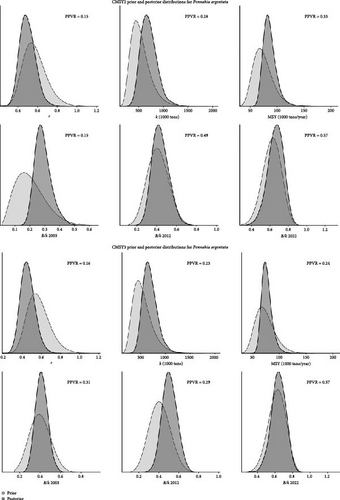
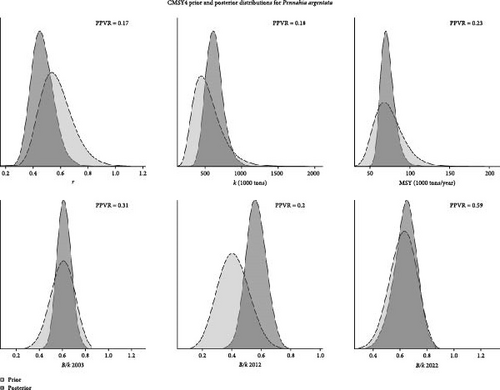
Appendix B
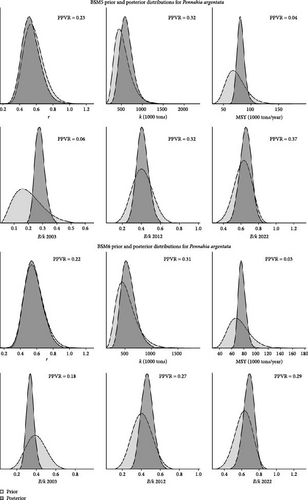
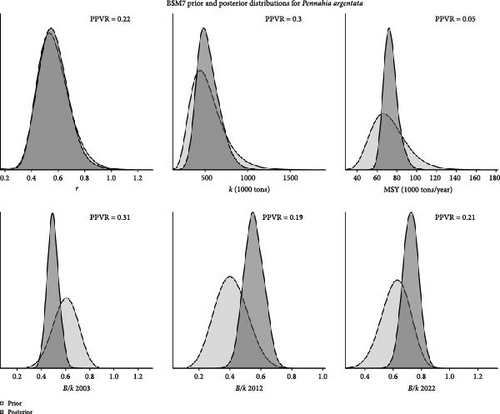
Appendix C
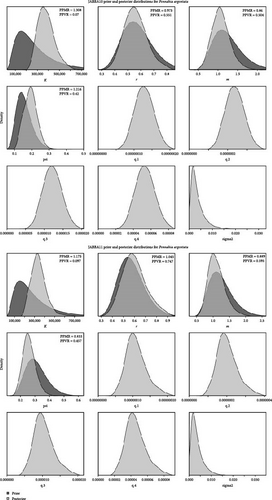
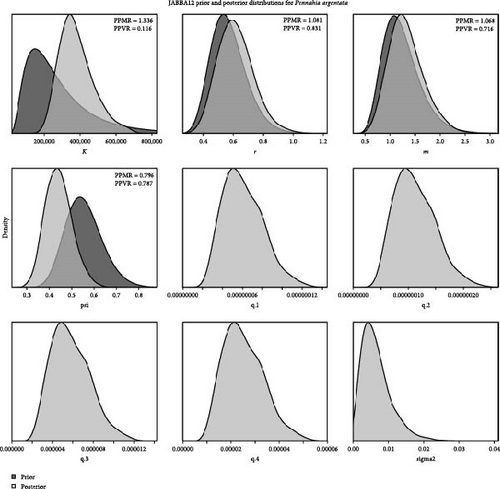
Open Research
Data Availability Statement
The data will be provided upon reasonable request from the author.




